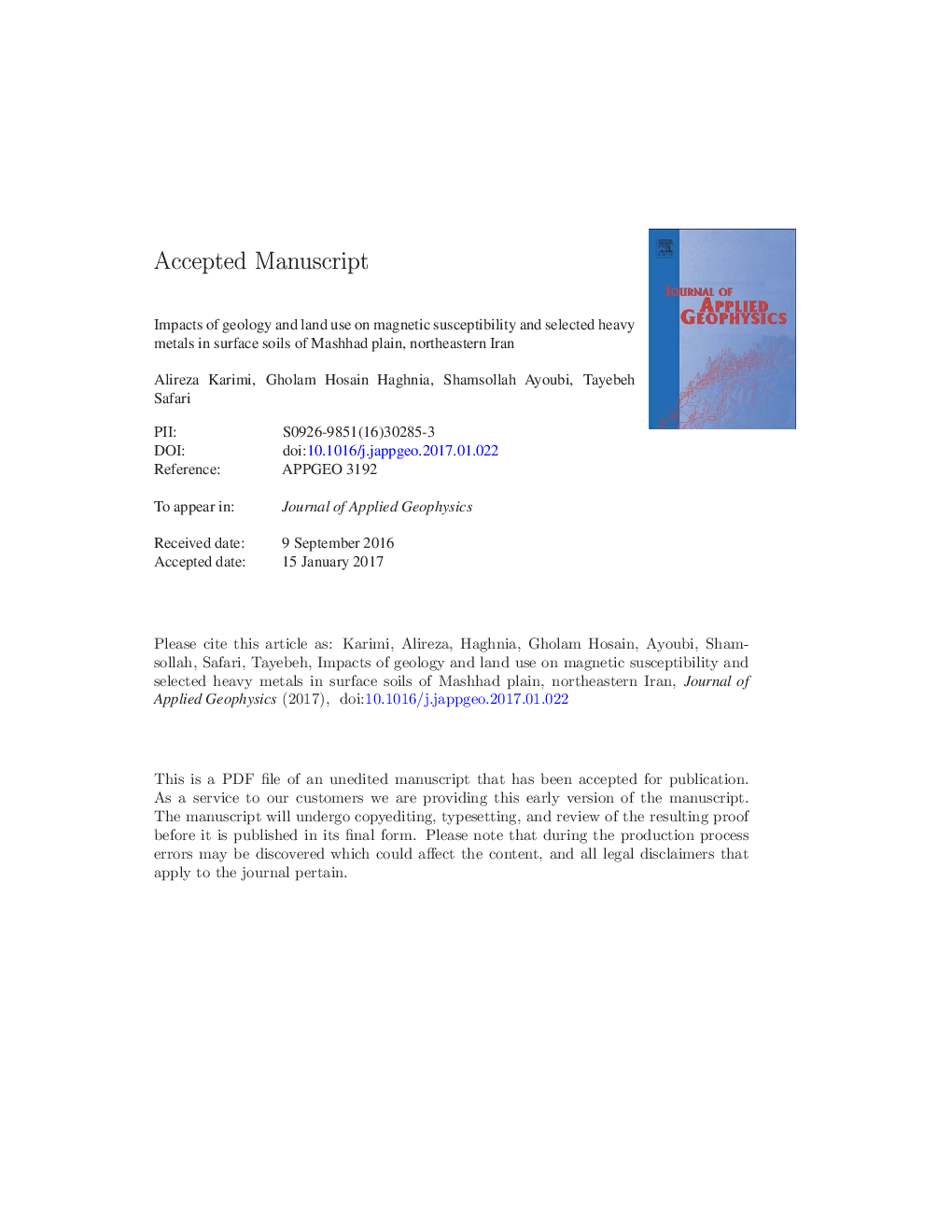| کد مقاله | کد نشریه | سال انتشار | مقاله انگلیسی | نسخه تمام متن |
|---|---|---|---|---|
| 5787204 | 1641113 | 2017 | 28 صفحه PDF | دانلود رایگان |
عنوان انگلیسی مقاله ISI
Impacts of geology and land use on magnetic susceptibility and selected heavy metals in surface soils of Mashhad plain, northeastern Iran
ترجمه فارسی عنوان
اثرات زمین شناسی و کاربرد زمین در حساسیت مغناطیسی و فلزات سنگین انتخاب شده در خاک های سطح دشت مشهد، شمال شرقی ایران
دانلود مقاله + سفارش ترجمه
دانلود مقاله ISI انگلیسی
رایگان برای ایرانیان
کلمات کلیدی
موضوعات مرتبط
مهندسی و علوم پایه
علوم زمین و سیارات
فیزیک زمین (ژئو فیزیک)
چکیده انگلیسی
Magnetic susceptibility is a fast, inexpensive and reliable technique for estimating and monitoring the anthropogenic contamination of soil with heavy metals. However, it is essential to determine the factors affecting magnetic susceptibility before applying this technique to environmental studies. The objectives of this study were to investigate i) the effect of parent materials and land use on the magnetic susceptibility and concentrations of Fe, Ni, Pb and Zn, and ii) capability of magnetic susceptibility as an indicator of anthropogenic heavy metals contamination of soil in Mashhad plain, northeastern Iran. One hundred seventy-eight composite surface soil samples (0-10 cm) were taken. The aqua-regia extractable concentrations of Fe, Ni, Zn and Pb were determined by atomic absorption spectroscopy. Magnetic susceptibility at low and high frequency (Ïlf and Ïhf) were measured and frequency dependent susceptibility (Ïfd) was calculated. The average concentrations of Fe, Ni, Pb and Zn were 22,812, 61.4, 74.1 and 31.6 mg kgâ 1, respectively. The highest contents of Pb (69.1 mg kgâ 1) and Zn (149 mg kgâ 1) were observed in urban area. The highest concentration of Ni was 41,538 mg kgâ 1 observed in the soils developed from ultramafic rocks. Magnetic susceptibility varied from 20.3 on marly sediments to 311.8 Ã 10â 8 m3 kgâ 1 on ultramafic rocks. A positive strong correlation (Pvalue < 0.01, r = 0.88) was obtained between Ni and Ïlf. There were no significant relationships between Zn and Pb with Ïlf, therefore it seems that magnetic susceptibility has not been affected significantly by anthropogenic activities which enhanced Pb and Zn concentrations in urban soils. The results indicated that magnetic susceptibility was mainly controlled by Ni containing minerals with lithogenic origin. Therefore, in the soils studied, magnetic susceptibility could not be employed as indicator of anthropogenic contamination of soil with heavy metals.
ناشر
Database: Elsevier - ScienceDirect (ساینس دایرکت)
Journal: Journal of Applied Geophysics - Volume 138, March 2017, Pages 127-134
Journal: Journal of Applied Geophysics - Volume 138, March 2017, Pages 127-134
نویسندگان
Alireza Karimi, Gholam Hosain Haghnia, Shamsollah Ayoubi, Tayebeh Safari,
